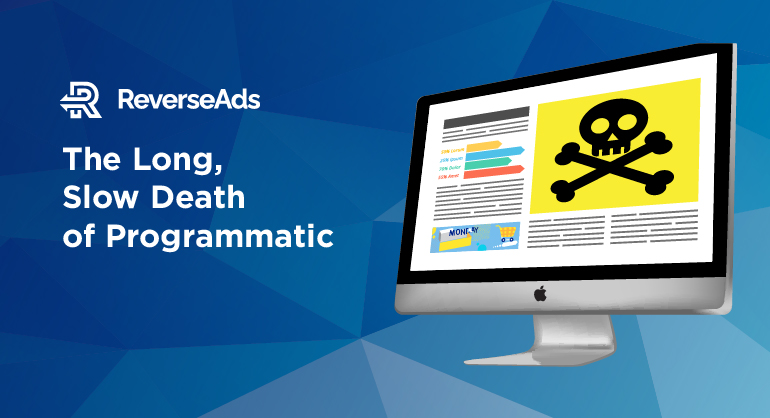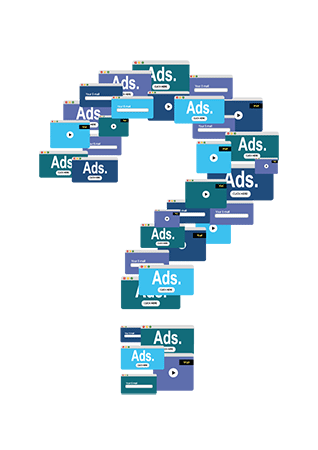The Long, Slow Death of Programmatic

Digital advertising has gone through many transformations since the first online ad ran in 1994. Now, in 2020, we are on the cusp of the next major shift. Programmatic display has been the driving force behind digital ad campaigns since real-time bidding software exploded in 2007. However, with recent developments in data privacy and the resulting technological changes, many businesses and media buyers are asking themselves… is programmatic dead?
It’s easy to see why programmatic rose to prominence. It allowed businesses to improve the accuracy of their targeting and hone their creative strategies based on third-party user data. The ease at which a company could buy digital ads in real-time through A.I. and machine learning led to a massive disruption in the advertising industry. But as we all know, technologies change quickly, and consumer expectations adjust in tandem with significant technological advancements. Now that we are over 25 years into the life of the internet, and society has shifted almost all processes to the digital space, individuals and businesses are concerned about security and privacy. These concerns have manifested in both laws and regulations that are changing the nature of data collection. But what does this mean for programmatic advertising?
The End of Third-Party Cookies

Third-party cookies have been at the center of digital ad targeting since the
early days of programmatic. These pieces of data allow Adtech companies to place information on a user’s device, making it possible to track their actions online and see what sites and content they are interacting with. As a result, each user generates data related to their interests, geography, and other demographic information that can be used to improve the accuracy of the ads they are being served. The use of third-party cookies has come under fire, as some companies used this technology without transparency or even a user’s consent. As frustrations grew around the use of third-party cookies, governments began passing laws such as CCPA, ePR, and GDPR, aiming to protect users’ privacy rights online. With the passing of these laws, the stakes rose, and now all major browser developers, including Apple, Firefox, and Google, are ending the support of third-party cookies. Interestingly, there are some misunderstandings about the actual security concerns related to the third-party cookie, as alone, it is entirely anonymous. The real security issues are created as soon as you combine this data with form-data sent in tandem with a cookie. This means that any cookie or ID can be linked with form-data and lead to privacy concerns.

Email as the False Savior
Due to the impending cookieless future, some businesses have placed their hope in the use of email addresses to act as an identifier. This reliance on email data is based on the fact that platforms will only have first-party cookies at their disposal. This data is stored directly in each unique website that a user visits. As a result, each user will have a different first-party cookie ID on each unique website that they navigate to. The connective tissue between all of these IDs is the user’s email, which will allow businesses to assemble a comprehensive profile that details all of the user’s interests and behavior. This means that instead of device IDs, companies will link a user’s data to their email. The ironic thing about this shift is that it is arguably more intrusive, as consumers will be offering up offline data generated from any instance that they provided an email address for digital receipts. This deepens the challenge of adhering to regulations and policies established to restrict consumer data collected by businesses worldwide.
First-Party Customer Data
While third-party cookies are created by external domains and not the actual website you are visiting, first-party cookies are stored directly within the websites you visit. This privatizes the data, allowing website owners to collect and analyze it directly from their own domains. Now that the industry is moving away from third-party cookies and towards first-party, consent becomes much more relevant. Consent platforms can ensure that consumers are protected from undesired tracking, while also meeting a company’s advertising needs. The way in which consent platforms and first-party cookies work together makes it possible to securely track and retarget users while maintaining anonymous user ID data. Consumers have much more control over the safety of their experience, and businesses are figuring out how to safely track these users in a compliant and consent driven way.
So…Is Programmatic Really Dying?
Businesses will always be working to understand and track their consumers. As technology evolves and regulations are adopted, these same businesses will figure out how to continue these processes in compliant and secure ways. While the data being collected and accessed might not be the same as it has been since the birth of programmatic, ad tech vendors will be forced to innovate and unlock new ways to achieve relevance. This is why many experts believe that programmatic is not necessarily dying, but rather changing form as it adapts to a world without third-party cookies. There is still a chance that the result will be difficult to recognize when compared to the programmatic technologies that have driven the industry forward since 2007. However, more likely is that companies will shift to a more privacy-focused approach while still generating the data necessary for successful digital ad campaigns.
ReverseAds Cookieless Tracking
Since the implementation of GDPR, CASL, and CCPA, we have been hard at work, creating an unparalleled cookie-less tracking solution that is compliant and scalable. Our solution does not track user-level data, but rather campaign-level engagement tied explicitly to a keyword’s intent. Using client-side, first-party cookies, we can read/write information specific to that user while storing this data anonymously. This allows us to read engagement from a particular user across all modern browsers, without being affected by Apple’s ITS or Chrome 3rd Party Cookie blocking.
Our solution has helped global brands like BMW, Harley Davidson, and RE/MAX transform their digital advertising with an eye toward the future. If you’d like to learn how to deploy our cookie-less tracking solution and generate more engagement and conversions sustainably, visit https://www.reverseads.com/ or email us at info@reverseads.com to schedule a time to speak with a ReverseAds Data Intelligence Specialist.





